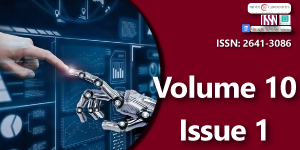A Highly Efficient Computational Method for Particle Search and Positioning in 3D Cells: The Volume Comparison and Cartesian Cell Registration Approach
Main Article Content
Abstract
This study introduces a notably simple and effective computational method for particle search and positioning in 3D cells by combining the newly proposed Volume Comparison (VC) method with the Cartesian Cell Registration (CCR) method. Our method achieves a remarkable speed-up ratio of 9,675 relative to the brute-force search in rarefied gas flow simulations using the DSMC method with 61,047 computational 3D cells. Furthermore, our results indicate that the proposed method is approximately 4.45 to 5.73 times faster than the conventional methods, due to the reduced number of cells that need to be searched. Moreover, it eliminates the time step restrictions inherent in the conventional methods by permitting particles to move beyond adjacent cells, thereby enabling larger time steps and reducing overall computational cost. Additionally, our method precisely performs particle search and positioning—determining whether a particle is located within three-dimensional convex or concave cells, regardless of type—and facilitates efficient computation of residence times by geometrically analyzing particle trajectories and their intersections with cell boundaries. These techniques effectively address challenges such as handling moving or deforming meshes without necessitating re-registration, employing the inverse deformation function to ensure robustness. By combining accuracy with computational efficiency, the VC and CCR methods prove highly effective for advanced simulations involving particle search and positioning in complex 3D environments, such as rarefied gases, solvents, diesel sprays in engines, molecules in nanoscale flows, the dynamics of granular materials, and the gas-phase equations of multiphase flows.
Downloads
Article Details
Copyright (c) 2016 Yoshifumi Ogami

This work is licensed under a Creative Commons Attribution-NonCommercial 4.0 International License.
Bird GA. Direct simulation and the Boltzmann equation. Phys Fluids. 1970;13(11):2676–81. doi:10.1063/1.1692849
Bird GA. Molecular gas dynamics and the direct simulation of gas flows. Oxford: Oxford University Press; 1994. doi:10.1093/oso/9780198561958.001.0001
Bird GA. The DSMC method. Version 1.2. 2018. Available from: https://www.createspace.com/3689652
Gousbet G, Berlemont A. Eulerian and Lagrangian approaches for predicting the behaviour of discrete particles in turbulent flows. Prog Energy Combust Sci. 1999;25:133–59. doi:10.1016/S0360-1285(98)00018-5
Nordin N. Complex chemistry modeling of diesel spray combustion [dissertation]. Gothenburg (Sweden): Chalmers University of Technology; 2000. Available from: https://www.researchgate.net/publication/296962896_Complex_chemistry_modeling_of_diesel_spray_combustion
Macpherson GB, Reese JM. Molecular dynamics in arbitrary geometries: Parallel evaluation of pair forces. Mol Simul. 2008;34(1):97–115. doi:10.1080/08927020801930554
Macpherson GB, Nordin N, Weller HG. Particle tracking in unstructured, arbitrary polyhedral meshes for use in CFD and molecular dynamics. Commun Numer Methods Eng. 2009;25(3):263–73. doi:10.1002/cnm.1128
Hemph R, Svensson J, van Wachem BGM, Almstedt AE. Discrete element simulations and experimental validation of particle packing in a 5 mm chromatography column. In: Proceedings of the 6th International Conference on Multiphase Flow; 2007; Leipzig, Germany.
Chen XQ, Pereira JCF. A new particle-locating method accounting for source distribution and particle-field interpolation for hybrid modelling of strongly coupled two-phase flows in arbitrary coordinates. Numer Heat Transf B Fundam. 1999;35(1):41–63. doi:10.1080/104077999276009
Vaidya AM, Subbarao PMV, Gaur RR. A novel and efficient method for particle locating and advancing over deforming, nonorthogonal mesh. Numer Heat Transf B Fundam. 2006;49(1):67–88. doi:10.1080/10407790500344043
Shojaee S, Hosseini SH, Razavi BS. Computational fluid dynamics simulation of multiphase flow in structured packings. J Appl Math. 2012;2012:1–17. Available from: http://bit.ly/3uVEvUD
Parsi M, Kara M, Agrawal M, Kesana N, Jatale A. CFD simulation of sand particle erosion under multiphase flow conditions. Wear. 2017;376–377:1176–84. Available from: http://bit.ly/2OmxGKY
Florice NM, Andrei K. Modelling and simulation of multiphase flow applicable to processes in oil and gas industry. Chem Prod Process Model. 2019;20170066:1–16.
Chen XQ. Efficient particle tracking algorithm for two-phase flows in geometries using curvilinear coordinates. Numer Heat Transf A Appl. 1997;31(4):387–405. doi:10.1080/10407789708913897
Zhou Q, Leschziner MA. An improved particle locating algorithm for Eulerian-Lagrangian computations of two-phase flows in general coordinates. Int J Multiph Flow. 1999;25(4):813–25. doi:10.1016/S0301-9322(98)00083-8
Chordá R, Blasco JA, Fueyo N. An efficient particle-locating algorithm for application in arbitrary 2D and 3D grids. Int J Multiph Flow. 2002;28(9):1565–80. doi:10.1016/S0301-9322(02)00045-9
Wu JS, Lian YY. Parallel three-dimensional direct simulation Monte Carlo method and its applications. Comput Fluids. 2003;32(9):1133–60. doi:10.1016/S0045-7930(02)00083-X
Mallikarjun S, Casseau V, Yang G, Huang JY, Habashi WG, Gao S, et al. HALO3D: An all-Mach approach to hypersonic flows simulation, Part II. Int J Comput Fluid Dyn. 2024. doi:10.1080/10618562.2024.2306946
Liang J, Yan C, Du BQ. An algorithm study of three-dimensional DSMC simulation based on two-level Cartesian coordinates grid structure. Acta Aerodyn Sin. 2010;28:466–71. Available from: https://pubs.cstam.org.cn/article/id/kqdlxxb_10389
Wang Z, Li L, Zhang B, Liu H. BCP particle positioning techniques for DSMC method. J Aeronaut Astronaut Aviat. 2019;51:225–36. Available from: https://www.researchgate.net/publication/384145115_BCP_Particle_Positioning_Techniques_for_DSMC_Method
Wang C, Cheng J, Ji L, Lu Y, Sun Y. 2-D DSMC algorithm based on Delaunay triangles. J Tsinghua Univ Sci Technol. 2015;55:1079–86. Available from: https://bit.ly/2OmzcwU
Ogami Y. Fast algorithms for particle searching and positioning by cell registration and area comparison. Trends Comput Sci Inf Technol. 2021;6(1):7–16. doi:10.17352/tcsit.000032
Ogami Y, Kamran S. Fast particle search and positioning algorithms using an efficient cell registration method. In: Andriychuk M, Sadollah A, editors. Optimization algorithms - Classics and recent advances. London: IntechOpen; 2023. p. 105–24. doi:10.5772/intechopen.112068
Sharipov F, Volkov AN. Aerothermodynamics of a sphere in a monatomic gas based on ab initio interatomic potentials over a wide range of gas rarefaction: Transonic, supersonic, and hypersonic flows. J Fluid Mech. 2022;942:A17. doi:10.1017/jfm.2022.356

